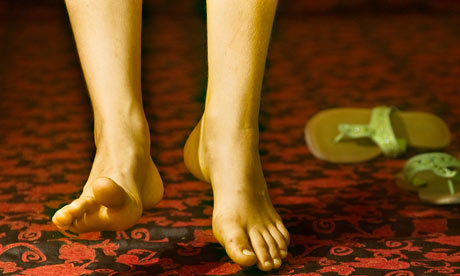
Neurologists call it the "commonest movement disorder you've never heard of". Restless Legs Syndrome (RLS) – or Ekbom's disease – is the uncontrollable urge to move your legs when resting. About 5-10% of adults will develop it (around five million people in the UK), but while some will just experience a sporadic twitchiness at the end of the day, for others the condition is a torment.
Symptoms usually begin during the evenings or at night and are variously described as burning, creeping, itching, aching or tugging sensations in the legs; the feeling of insects crawling around inside; or of "Coca-Cola in the blood". The only relief is movement. Trying to stay still, says Julian Spinks, an RLS specialist, "Is like trying to eat a doughnut without licking your lips."
Long-haul flights, car journeys or any trip where you have to sit still for long can be unbearable. "It's almost impossible for me to go to the theatre," says Emma, 42, whose symptoms are getting worse with age. "Nowadays I can only go if I take half a valium."
"At the cinema, or on flights, you worry that you're bothering everyone around you by shifting all the time. Going out to dinner is agony too. "By 10pm my legs are twitching so much I have to get up and walk around."
Tiredness exacerbates the problem, but relaxation is often out of the question. "It can get unbelievably infuriating in the evenings. The more tired I am, the worse it is," says Dawn, 38, who has had RLS for 20 years. "I've set up a mini-trampoline in the front room and I get on and off it when we're watching TV. It irritates my husband beyond belief, but it's better than me thrashing next to him."
Not surprisingly, RLS can push relationships to breaking point. "If your partner is waking multiple times a night it puts a strain on you both," says Spinks. Couples often end up in separate beds. "People get so desperate they'll even batter their own legs for relief – British people use umbrellas, Americans tend to use baseball bats," he says.
RLS is caused by an imbalance in the neurotransmitter dopamine. "A lack of dopamine in one area of the brain can trigger it," says Spinks. There is also a genetic link, with around half of sufferers inheriting the condition. Many remember a parent having the evening jitters, but it is only when they develop symptoms, then get a diagnosis themselves, that they understand why. Women tend to get RLS more often than men and symptoms often worsen with age.
The disease can also be linked to low iron levels, though exactly how this is related to dopamine is not yet understood (pregnant women sometimes develop RLS because of fluctuating iron levels during pregnancy). Other triggers include common medications such as cold and flu remedies (although no one knows why), antihistamines or antidepressants. Symptoms can also be caused by chronic diseases such as kidney failure (where there can be problems with the body's iron and mineral levels), or Parkinson's disease.
But misdiagnosis is common and treatment is difficult. Doctors have been known to confuse RLS with depression, stress, sciatica or arthritis, so Spinks trains GPs to look for these symptoms: an urge to move, that comes on while resting, is better after movement, and is worse at night.
Lifestyle changes such as cutting out caffeine, alcohol and tobacco help ease the condition in some people. And when the symptoms come on, a hot bath or shower, leg massage, or a hot water bottle might bring relief. Iron supplements can help too, or a low dose of magnesium (iron and magnesium deficiency can be connected), but severe cases may need drug treatments.
"There is no cure," says Spinks. "But I often see people improve dramatically when given medication." There are drugs that mimic the action of dopamine in the brain, or anti-epileptic drugs that change the way nerve cells talk to each other, helping to ease painful symptoms of RLS, as well as helping to stop involuntary limb movements.
However, some people actually get worse with these treatments. There are also side effects such as nausea or even, in rare cases, compulsive behaviour (in particular, compulsive gambling – which dopamine can help trigger). Usually, patients turn to medication when bouts of RLS are particularly bad, so it isn't used all the time, but medication may have to be taken for many years.
The condition can feel like a life- sentence and sufferers often dread passing it to their children. "I worry that my daughter may have it," says Emma. "She's eight, and has growing pains, and I fear that the two are linked." In fact, there is no connection between growing pains and RLS. But RLS is sometimes mis-diagnosed in children as growing pains.
On the US website whatisrls.org, Lynne, 44, remembers what it was like to have RLS as a child. "I would be up pacing at night while my family was sleeping," she says. "I felt like I lived alone, living on the sidelines of my own life . . . the lack of sleep turns you into a different person."
"It has a trivial-sounding name," says Spinks. "But RLS can affect your whole life."

